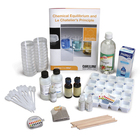Asking Questions and Defining Problems

DeeDee Whitaker
Product Content Specialist
April 2017
Scientists begin their investigations by asking questions. Engineers solve problems by first defining them. The act of asking questions indicates curiosity about a topic and an intent to acquire additional information. Asking questions and defining problems are practices that scientists and engineers regularly engage in as part of their routine. Asking questions and defining problems is the first practice in Dimension 1 of the Next Generation Science Standards (NGSS). Formulating a good question is difficult. Do your students have the skills and information they need to ask well-formulated and testable questions?
Vincent F. Hendricks, a professor of formal philosophy and logic, breaks down questions into 2 types: closed and open. Closed questions have clear answers, often yes or no. For example: What was your score on the last test? That question has a definite, numerical answer. Open questions require the responder to include considerations and assessments in the answer. For example: How did you prepare for your last test? The responder needs to consider if being prepared means, did I study, did I have the necessary materials, did I have adequate sleep? Hendricks states that the best questions are formatted so the answer depends on conditions and qualifications. A good question should be short, clear, and precise to avoid ambiguity. This is particularly true in science. A research question spells out conditions and qualifications by introducing variables and controls.
To help students become better question askers, Dan Rothstein and Luz Santana developed the Question Formulation Technique (QFT), which with slight modifications can be tailored to generate scientific questions. Notice that the QFT is similar to the scientific method and the engineering cycle.
QFT
- Find a focus
- Brainstorm
- Refine
- Prioritize
- Determine the next steps
- Reflect
Rothstein and Santana found that students who engage in questioning take more active ownership of their learning. They internalize the process of asking questions and apply the process to many aspects of their education and lives, hopefully with long-term benefits.
Since asking questions and defining problems have been identified as NGSS practices in science and engineering, it is paramount that we give students plenty of opportunities to build and refine their questioning skills. Below is a graphic organizer you can use to guide students through the question generation process.
Generating Questions

References
Ebdrup, N. 2014. How to ask the right questions. ScienceNordic, June 24, 2014. http://sciencenordic.com/how-ask-right-questions (accessed April 7, 2017).
Rothstein, D., and Santana, L. 2011. Teaching students to ask their own questions. Harvard Education Letter 27, no. 5 (September/October), http://hepg.org/hel-home/issues/27_5/helarticle/teaching-students-to-ask-their-own-questions_507 (accessed April 7, 2017).
Walker, S. 2011. 6 steps to help students ask better questions. The Science of Learning Blog, November 29, 2011, http://www.scilearn.com/blog/6-steps-to-help-students-ask-better-questions (accessed April 7, 2017).
















